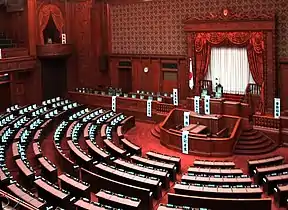
The National Diet of Japan is Japan's bicameral legislature. It is composed of a lower house, called the House of Representatives, and an upper house, called the House of Councillors. Both houses of the Diet are directly elected under a parallel voting system. In addition to passing laws, the Diet is formally responsible for selecting the Prime Minister. The Diet was first convened as the Imperial Diet in 1889 as a result of adopting the Meiji constitution. The Diet took its current form in 1947 upon the adoption of the postwar constitution and is considered by the Constitution to be the highest organ of state power. The National Diet Building is located in Nagatachō, Chiyoda, Tokyo. The houses of the Diet are elected under a parallel voting system. This means that the seats to be filled in any given election are divided into two groups, each elected by a different method; the main difference between the houses is in the sizes of the two groups and how they are elected. Voters are also asked to cast two votes: one for an individual candidate in a constituency, and one for a party list. Any citizen of Japan at least twenty years of age (the age of majority in Japan) may vote in these elections. Japan's parallel voting system is not to be confused with the Additional Member System used in many other nations. The Constitution of Japan does not specify the number of members of each house of the Diet, the voting system, or the necessary qualifications of those who may vote or be returned in parliamentary elections, thus allowing all of these things to be determined by law. However it does guarantee universal adult suffrage and a secret ballot. It also insists that the electoral law must not discriminate in terms of "race, creed, sex, social status, family origin, education, property or income". (Full article...)